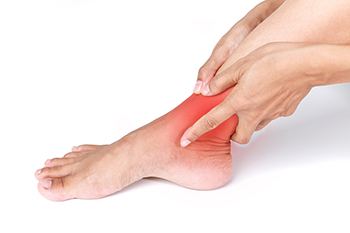May 2023
Foot Pain May Indicate Health Issues

Having persistent foot conditions may indicate there may be issues with overall health. Foot cramps can be a sign of dehydration, and may be remedied by drinking plenty of water. Morton’s neuroma can cause a tingling or burning sensation between the third and fourth toes and can happen from wearing shoes that do not have enough room for the toes to move freely in. Flakey skin may be a symptom of athlete's foot, which is caused by a fungal infection. Some patients have consistently cold feet, despite warm socks that are worn. This could mean there are circulatory issues, and it may be accompanied by fatigue. If you have foot pain for any reason, it is strongly suggested that you consult with a podiatrist who can provide treatment, in addition to determining if the foot pain represents an underlying health condition.
Foot Pain
Foot pain can be extremely painful and debilitating. If you have a foot pain, consult with Milos Tomich, DPM from Dr. Tomich Foot & Ankle Health Center. Our doctor will assess your condition and provide you with quality foot and ankle treatment.
Causes
Foot pain is a very broad condition that could be caused by one or more ailments. The most common include:
- Bunions
- Hammertoes
- Plantar Fasciitis
- Bone Spurs
- Corns
- Tarsal Tunnel Syndrome
- Ingrown Toenails
- Arthritis (such as Gout, Rheumatoid, and Osteoarthritis)
- Flat Feet
- Injury (from stress fractures, broken toe, foot, ankle, Achilles tendon ruptures, and sprains)
- And more
Diagnosis
To figure out the cause of foot pain, podiatrists utilize several different methods. This can range from simple visual inspections and sensation tests to X-rays and MRI scans. Prior medical history, family medical history, and any recent physical traumatic events will all be taken into consideration for a proper diagnosis.
Treatment
Treatment depends upon the cause of the foot pain. Whether it is resting, staying off the foot, or having surgery; podiatrists have a number of treatment options available for foot pain.
If you have any questions, please feel free to contact one of our offices located in Milwaukee and Wauwatosa, WI . We offer the newest diagnostic and treatment technologies for all your foot care needs.
It's Time for Beautiful Feet
What Is Twisting the Ankle?

Even novices to the field of podiatry might be familiar with what some people call a twisted ankle. But what exactly does it mean to twist one’s ankle? The answer is that twisting the ankle is another way to say that the foot is inverted or moved outwards in an awkward position. As a result of this, an individual might suffer an ankle sprain. The patient’s outer, or lateral, ligaments might be stretched past their natural point, contributing to the sprain. There are many common symptoms associated with a sprained ankle. For example, a person might experience pain, swelling, or bruising. Importantly, a sprained ankle is distinct from a broken ankle, which occurs when the ankle bone becomes fractured. If you are someone that is currently living with a twisted or sprained ankle, it is suggested that you contact a podiatrist to schedule an appointment today.
Ankle sprains are common but need immediate attention. If you need your feet checked, contact Milos Tomich, DPM from Dr. Tomich Foot & Ankle Health Center. Our doctor can provide the care you need to keep you pain-free and on your feet.
How Does an Ankle Sprain Occur?
Ankle sprains take place when the ligaments in your ankle are torn or stretched beyond their limits. There are multiple ways that the ankle can become injured, including twisting or rolling over onto your ankle, putting undue stress on it, or causing trauma to the ankle itself.
What Are the Symptoms?
- Mild to moderate bruising
- Limited mobility
- Swelling
- Discoloration of the skin (depending on severity)
Preventing a Sprain
- Wearing appropriate shoes for the occasion
- Stretching before exercises and sports
- Knowing your limits
Treatment of a Sprain
Treatment of a sprain depends on the severity. Many times, people are told to rest and remain off their feet completely, while others are given an air cast. If the sprain is very severe, surgery may be required.
If you have suffered an ankle sprain previously, you may want to consider additional support such as a brace and regular exercises to strengthen the ankle.
If you have any questions please feel free to contact one of our offices located in Milwaukee and Wauwatosa, WI . We offer the newest diagnostic and treatment technologies for all your foot and ankle needs.
Concerns with Toe Walking in Children

As toddlers learn to walk, they often place more weight on their toes than on the heels or soles of the feet. Experts believe that this is not necessarily indicative of any underlying medical condition or biomechanical abnormality. In fact, recent studies show that most toe walkers will outgrow this habit by the time they enter kindergarten. That said, if a child continues to walk on their toes as they get older, it may in fact may be a sign of neuromuscular or neurodevelopmental disorders, such as cerebral palsy or autism. Symptoms to watch for include stiff leg muscles, tightened Achilles tendons, and noticeable lack of coordination. Additionally, noticing a period of normal walking followed by toe walking, communication problems, and other physical abnormalities may be signs to visit a specialist. In those cases, it is suggested that parents who notice these symptoms contact a podiatrist. This type of foot doctor, who is trained to recognize the significance of such behaviors, can then examine the child’s gait, legs, and feet to determine the best course of action.
The health of a child’s feet is vital to their overall well-being. If you have any questions regarding foot health, contact Milos Tomich, DPM of Dr. Tomich Foot & Ankle Health Center. Our doctor can provide the care you need to keep you pain-free and on your feet.
Tips for Keeping Children's Feet Healthy
- Make sure their shoes fit properly
- Look for any signs of in-toeing or out-toeing
- Check to see if they have Clubfoot (condition that affects your child’s foot and ankle, twisting the heel and toes inward) which is one of the most common nonmajor birth defects.
- Lightly cover your baby’s feet (Tight covers may keep your baby from moving their feet freely, and could prevent normal development)
- Allow your toddler to go shoeless (Shoes can be restricting for a young child’s foot)
- Cut toenails straight across to avoid ingrown toenails
- Keep your child’s foot clean and dry
- Cover cuts and scrapes. Wash any scratches with soap and water and cover them with a bandage until they’ve healed.
If you have any questions, please feel free to contact one of our offices located in Milwaukee and Wauwatosa, WI . We offer the newest diagnostic and treatment technologies for all your foot care needs.
What Can Cause an Achilles Tendon Injury?

The band of tissue that connects the calf muscles to the heel is called the Achilles tendon. This tendon helps the body to walk, run, and jump, in addition to standing on tiptoes. When an Achilles tendon injury is experienced, it can cause a great deal of pain and discomfort. Common causes include increasing speed and distance too quickly while running and training on hard or uneven surfaces. Additionally, long-term conditions such as rheumatoid arthritis, diabetes, or thyroid disorders may lead to Achilles tendon injuries. Some of the symptoms associated with this ailment are stiffness, dull or sharp heel pain, and the back of the ankle may be swollen. If the injury is severe, surgery may be an option to consider for permanent repair. If you have endured an Achilles tendon injury, it is suggested that you consult a podiatrist who can provide the treatment solution that is right for you.
Achilles tendon injuries need immediate attention to avoid future complications. If you have any concerns, contact Milos Tomich, DPM of Dr. Tomich Foot & Ankle Health Center. Our doctor can provide the care you need to keep you pain-free and on your feet.
What Is the Achilles Tendon?
The Achilles tendon is a tendon that connects the lower leg muscles and calf to the heel of the foot. It is the strongest tendon in the human body and is essential for making movement possible. Because this tendon is such an integral part of the body, any injuries to it can create immense difficulties and should immediately be presented to a doctor.
What Are the Symptoms of an Achilles Tendon Injury?
There are various types of injuries that can affect the Achilles tendon. The two most common injuries are Achilles tendinitis and ruptures of the tendon.
Achilles Tendinitis Symptoms
- Inflammation
- Dull to severe pain
- Increased blood flow to the tendon
- Thickening of the tendon
Rupture Symptoms
- Extreme pain and swelling in the foot
- Total immobility
Treatment and Prevention
Achilles tendon injuries are diagnosed by a thorough physical evaluation, which can include an MRI. Treatment involves rest, physical therapy, and in some cases, surgery. However, various preventative measures can be taken to avoid these injuries, such as:
- Thorough stretching of the tendon before and after exercise
- Strengthening exercises like calf raises, squats, leg curls, leg extensions, leg raises, lunges, and leg presses
If you have any questions please feel free to contact one of our offices located in Milwaukee and Wauwatosa, WI . We offer the newest diagnostic tools and technology to treat your foot and ankle needs.
Stretches After an Ankle Injury

People who have endured an ankle injury often realize the importance of performing specific stretches that are designed to strengthen the foot. It is beneficial to start out slowly, then gradually increase intensity as the pain levels adjust and eventually diminish. Many people who start stretching after an ankle injury often gauge it by the pain levels. The stretches can be successfully accomplished when the pain is kept between a level of 0 to 5, with excessive discomfort rating a 10. If the pain becomes unbearable, it may help to increase resting times between movements and reduce the speed at which a stretch is done. Many patients find it is beneficial to exercise in small increments during the course of the day. This may help to prevent fatigue, and it may lead to possibly increasing repetitions. A desirable time frame to hold a foot stretch can range between 20 and 30 seconds. The goal is to increase the range of motion and the time the stretch is held. If you would like more information about the importance of performing stretching techniques after an ankle injury, it is suggested that you confer with a podiatrist.
Ankle pain can have many different causes and the pain may potentially be serious. If you have ankle pain, consult with Milos Tomich, DPM from Dr. Tomich Foot & Ankle Health Center. Our doctor will assess your condition and provide you with quality foot and ankle treatment.
Ankle pain is any condition that causes pain in the ankle. Due to the fact that the ankle consists of tendons, muscles, bones, and ligaments, ankle pain can come from a number of different conditions.
Causes
The most common causes of ankle pain include:
- Types of arthritis (rheumatoid, osteoarthritis, and gout)
- Ankle sprains
- Broken ankles
- Achilles tendinitis
- Achilles tendon rupture
- Stress fractures
- Tarsal tunnel syndrome
- Plantar fasciitis
Symptoms
Symptoms of ankle injury vary based upon the condition. Pain may include general pain and discomfort, swelling, aching, redness, bruising, burning or stabbing sensations, and/or loss of sensation.
Diagnosis
Due to the wide variety of potential causes of ankle pain, podiatrists will utilize a number of different methods to properly diagnose ankle pain. This can include asking for personal and family medical histories and of any recent injuries. Further diagnosis may include sensation tests, a physical examination, and potentially x-rays or other imaging tests.
Treatment
Just as the range of causes varies widely, so do treatments. Some more common treatments are rest, ice packs, keeping pressure off the foot, orthotics and braces, medication for inflammation and pain, and surgery.
If you have any questions, please feel free to contact one of our offices located in Milwaukee and Wauwatosa, WI . We offer the newest diagnostic and treatment technologies for all your foot care needs.





